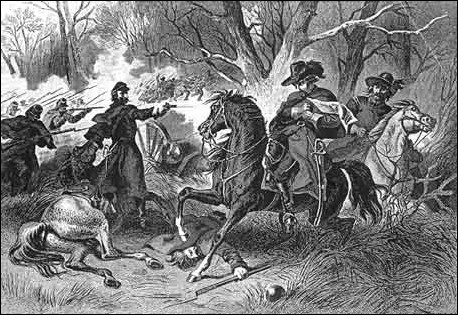January 19, 1862 – February 1, 1862
By Phil Kohn
Phil Kohn can be reached at USCW160@yahoo.com.
On January 19, 1862, Confederate Brig. Gen. Felix Zollicoffer is killed at the Battle of Mill Springs, Kentucky, a victory for Union troops led by Brig. Gen. George Thomas, a Virginian by birth. The federals capture 10 cannon, 100 wagons and over 1,000 horses. The Confederates are forced to withdraw into Tennessee. Maj. Gen. Crittenden, the overall Confederate commander, is reprimanded for losing control of the positioning of his troops. (Zollicoffer, against Crittenden’s orders had moved his troops north of the Cumberland River; the remainder of the Confederate force was on the south bank.) More importantly, the Confederate defeat leaves a gap in the Southerners’ Kentucky-Tennessee line of defense.
In South Carolina, the U.S. Navy on January 20 attempts to disrupt blockade running by sinking stone-laden ships in the main channel of Charleston Harbor.
Former Virginia governor Henry Wise on January 22 is named commander of 3,000 Confederate troops on Roanoke Island, North Carolina. Threatening him are the 15,000 Union soldiers under Brig. Gen. Ambrose Burnside near Hatteras Inlet to the south. Wise makes multiple appeals to Richmond for reinforcements, but to no avail.
At Charleston, South Carolina, on January 23, the U.S. Navy sinks more stone-laden ships in the harbor to thwart the passage of Confederate vessels. The efforts are unsuccessful, however, as the ships are either sunk too far apart, allowing vessels to sail between them, or sunk too deeply, permitting ships to sail over them without impediment.
On January 26, Confederate Gen. Pierre Beauregard is transferred from northern Virginia to Kentucky to become second in command to Gen. Albert Sidney Johnston. This leaves Gen. Joseph E. Johnston (no relation to Albert) in full command in Virginia.
In an unusual move triggered by frustration at the inactivity of the Federal armies (and the navy) across all fronts, President Lincoln and Secretary of War Stanton on January 27 issue General War Order #1, which mandates all Union forces to move simultaneously against the enemy, effective February 22, 1862. From Mesilla, Confederate Territory of Arizona, Brig. Gen. Henry Sibley dispatches a company of Arizona Rangers (Co. A), under Capt. Sherod Hunter to occupy Tucson, 275 miles west, to protect the western flank of his invasion of New Mexico. In Paris, France, Emperor Louis Napoleon announces that the American Civil War “has seriously compromised our commercial interests.” France, however, will remain neutral for the time being.
In Little Rock, Arkansas, Maj. Gen. Earl Van Dorn assumes command of the 17,000 Confederate troops in the newly created Trans-Mississippi District on January 29.
The U.S. Navy, on January 30, at Greenport, New York (on the eastern tip of the north fork of Long Island), launches its first ironclad warship: USS Monitor. On the same day, Confederate commissioners Mason and Slidell finally arrive in England.
In England, on January 31, Queen Victoria reaffirms her country’s neutrality in the American civil war, disappointing the Confederacy, which hoped for political support from Great Britain (as well as from France, which also remains officially neutral). In Winchester, Virginia, Brig. Gen. Thomas Jackson receives orders directly from President Davis and Secretary of War Judah P. Benjamin to withdraw the troops that he had placed at Romney, in northwestern Virginia, because they feel his positioning of them exposed them to possible isolation by Federal forces. Jackson complies but, angry with the direct interference in his command, resigns his commission and requests that Virginia governor Letcher assign him as superintendent of Virginia Military Institute, in Lexington. Pressured by Governor Letcher and his former commander, Gen. Joseph E. Johnston, Jackson withdraws his resignation. The U.S. War Department establishes the U.S. Military Railroad, with Bvt. Maj. Gen. Daniel McCallum — former superintendent of the Erie Railway — as Military Director and Superintendent of U.S. Railroads. In practice, the organization will deal primarily with Southern railroads captured during the war.
Brig. Gen. Ulysses S. Grant on February 1 readies his troops to move out of Cairo, Illinois, and head for Confederate-held Fort Henry, on the Tennessee River in Tennessee. The overall commander of Federal troops in the West, Maj. Gen. Henry Halleck, in St. Louis, has approved the plan.








